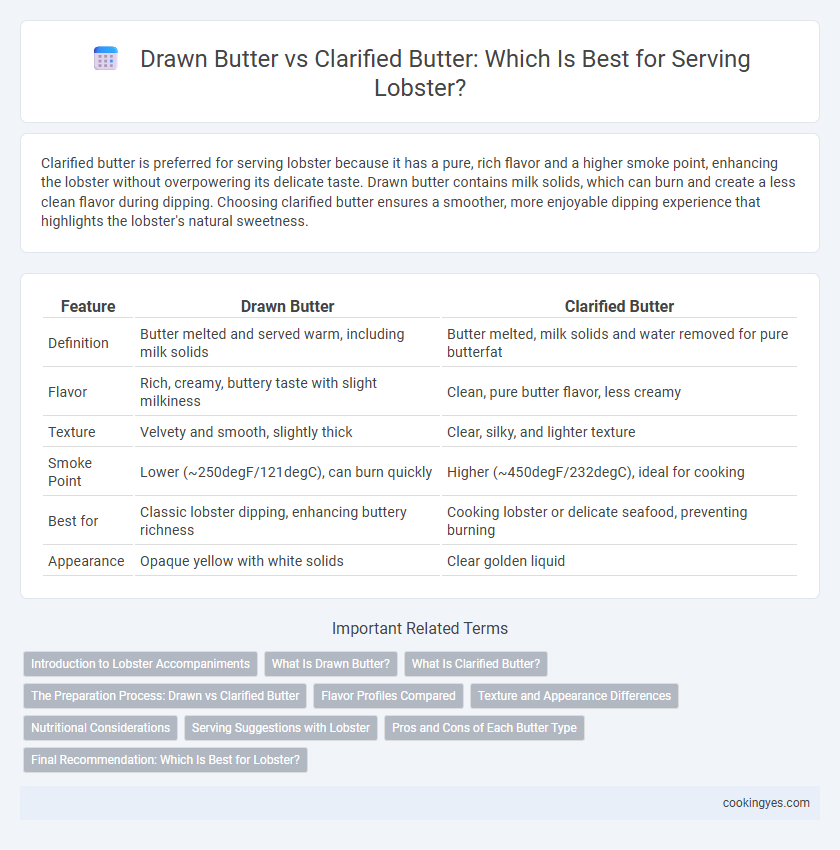Clarified butter is preferred for serving lobster because it has a pure, rich flavor and a higher smoke point, enhancing the lobster without overpowering its delicate taste. Drawn butter contains milk solids, which can burn and create a less clean flavor during dipping. Choosing clarified butter ensures a smoother, more enjoyable dipping experience that highlights the lobster's natural sweetness.
Table of Comparison
| Feature | Drawn Butter | Clarified Butter |
|---|---|---|
| Definition | Butter melted and served warm, including milk solids | Butter melted, milk solids and water removed for pure butterfat |
| Flavor | Rich, creamy, buttery taste with slight milkiness | Clean, pure butter flavor, less creamy |
| Texture | Velvety and smooth, slightly thick | Clear, silky, and lighter texture |
| Smoke Point | Lower (~250degF/121degC), can burn quickly | Higher (~450degF/232degC), ideal for cooking |
| Best for | Classic lobster dipping, enhancing buttery richness | Cooking lobster or delicate seafood, preventing burning |
| Appearance | Opaque yellow with white solids | Clear golden liquid |
Introduction to Lobster Accompaniments
Drawn butter, also known as melted butter, offers a rich, creamy texture that enhances the natural sweetness of lobster meat. Clarified butter, with its higher smoke point and pure fat content, provides a cleaner, more intense buttery flavor without milk solids. Choosing between these butters depends on whether you prefer a silky coating or a refined, concentrated taste to complement your lobster experience.
What Is Drawn Butter?
Drawn butter is melted butter served warm and often used as a dipping sauce for lobster, retaining its creamy texture and rich flavor. Unlike clarified butter, which has milk solids and water removed for a clear, pure butterfat, drawn butter includes the whole butter, providing a fuller taste experience. This makes drawn butter ideal for enhancing the natural sweetness of lobster without altering its delicate texture.
What Is Clarified Butter?
Clarified butter is pure butterfat extracted by melting butter and removing water and milk solids, resulting in a clear, golden liquid with a higher smoke point. This makes clarified butter ideal for serving lobster, enhancing its delicate flavor without burning or imparting a greasy texture. Compared to drawn butter, clarified butter offers a cleaner taste and longer shelf life, ensuring a luxurious and refined dipping experience.
The Preparation Process: Drawn vs Clarified Butter
Drawn butter is simply melted butter with milk solids and water separated but still present, requiring gentle heating to prevent burning. Clarified butter undergoes a more thorough process, involving simmering butter to remove all water and milk solids, resulting in a clear, pure fat with a higher smoke point. This distinction in preparation influences flavor and texture when serving lobster, with drawn butter offering richness and clarified butter providing a cleaner, more stable dipping option.
Flavor Profiles Compared
Drawn butter offers a rich, creamy texture with a slightly nutty flavor that enhances the natural sweetness of lobster. Clarified butter provides a purer, more concentrated buttery taste with a clean finish, allowing the delicate lobster flavor to shine without added milk solids. Choosing between the two depends on whether you prefer a smoother, mellow complement or a more intense, focused buttery accent.
Texture and Appearance Differences
Drawn butter has a rich, creamy texture with milk solids that give it a slightly opaque, golden appearance, enhancing the buttery flavor of lobster. Clarified butter offers a clear, bright yellow color and a smoother, more refined texture by removing milk solids and water. The choice between drawn and clarified butter affects the visual appeal and mouthfeel when served with lobster, with drawn butter providing a heartier, more velvety coating and clarified butter delivering a clean, elegant finish.
Nutritional Considerations
Drawn butter retains milk solids and water, providing a richer flavor but higher in saturated fats and cholesterol. Clarified butter, with milk solids and water removed, offers a purer fat content and longer shelf life, making it lower in lactose and potentially easier to digest. Choosing between them depends on dietary restrictions and preferences for saturated fat and lactose intake when serving lobster.
Serving Suggestions with Lobster
Drawn butter, with its rich and creamy texture, enhances lobster's natural sweetness by providing a smooth, warm dipping sauce that complements the delicate meat. Clarified butter, free of milk solids, offers a cleaner, more intense buttery flavor and higher smoke point, making it ideal for drizzling over lobster or for cooking methods like broiling and sauteing. Both butters serve distinct purposes: drawn butter excels as a traditional dip, while clarified butter is preferred for adding a pure butter taste without burning, elevating the overall lobster dining experience.
Pros and Cons of Each Butter Type
Drawn butter, prized for its rich flavor and easy preparation, enhances lobster's natural sweetness but contains milk solids that can burn and alter taste during reheating. Clarified butter, with milk solids removed, offers a higher smoke point and cleaner, pure buttery flavor ideal for dipping lobster without risk of burning. However, clarified butter lacks the creamy texture of drawn butter, which some prefer for a more indulgent lobster experience.
Final Recommendation: Which Is Best for Lobster?
Clarified butter is best for serving lobster because its pure butterfat enhances the rich, sweet flavor without the milk solids that can burn or alter the taste. Drawn butter has a milder profile and may contain milk solids, which can create a less clean finish. For an optimal lobster dipping experience, clarified butter offers a smoother texture and richer taste.
Drawn Butter vs Clarified Butter for serving lobster Infographic

 cookingyes.com
cookingyes.com